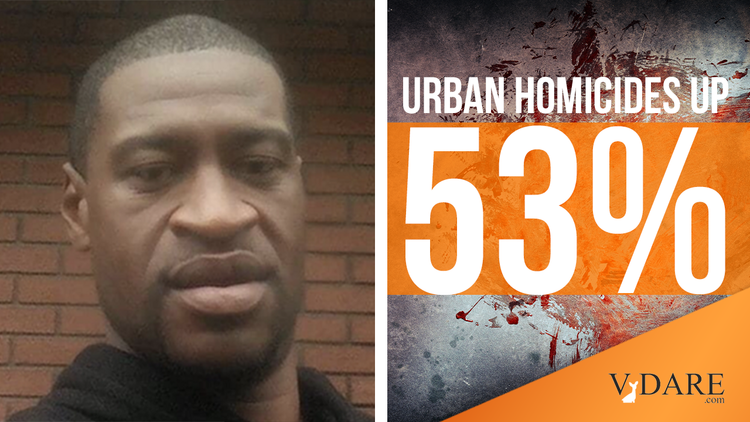
Urban Homicides Up 53% vs. 2019 During the Summer of George
10/30/2020
My October 14, 2020 Taki’s Magazine column “Slaughter in the Cities” quoted a report by liberal social scientist Richard Rosenfeld of the Council on Criminal Justice as showing in 20 big cities:
The model estimated a structural break near the end of May 2020, after which the homicide rate increased by 37% through the end of June.
Now, Rosenfeld has updated his report through the end of August:
HOMICIDE
Figure 1 displays the average weekly homicide rate in the 20 cities for which homicide data were available (see Appendix). There appears to be a rough cyclical pattern and a stable linear trend in the homicide rate over time. The model estimated a structural break at the end of May 2020, after which the homicide rate increased sharply through the beginning of July. It then dropped during the next several weeks through the end of August. The average city homicide rate between June and August of 2020 increased by 52.6% over the same three-month period the year before. There were 366 more homicides in the 20 cities during the summer of 2020 than during the summer of 2019.Note: The months June, July, and August are defined as “summer” in this report.
Key Takeaway: Homicide was 53% higher in summer 2020 than summer 2019.

In other words, up through Memorial Day, 2020 was somewhat worse than the recent normal for murders, but then all hell broke loose during the media-declared Racial Reckoning after George Floyd’s death on May 25.
From The New York Times news section write-up of the data, which is worth comparing to my earlier summarization:
Police Pin a Rise in Murders on an Unusual Suspect: Covid
Awash in new firearms, cities are drawing connections between the stresses of the coronavirus and a surge in homicides.
By Thomas Fuller and Tim Arango
Oct. 29, 2020OAKLAND, Calif. — Family and friends of Aaron Pryor say they may never know exactly why the 16-year-old star football player, a lightning-fast running back, was killed in broad daylight on a Sunday in September in a driveway near his Oakland home.
… “It was Covid that really killed this kid,” he said.
Like many American cities, where economies have been ravaged by the pandemic, Oakland has seen a surge in gun violence, including six killings of juveniles since June and a 40 percent increase in homicides over all. To the south, in Los Angeles, the picture is equally bloody, with the city on pace to have more than 300 homicides for the first time since 2009.
Beyond California, major cities from Minneapolis to Milwaukee to New York, and even smaller communities like Lubbock, Texas, and Lexington, Ky., are all confronting the same grim pattern, with some places, like Kansas City, Mo., and Indianapolis, setting records for the number of killings in a single year. Philadelphia, which was gripped by unrest this week after the police shooting of a Black man, is among the cities with the highest increase in homicides — its 404 killings this year are a more than 40 percent increase compared with the same period last year.
Criminologists studying the rise in the murder rate point to the effects the pandemic has had on everything from mental health to policing in a time of social distancing, with fewer officers able to perform the up-close-and-personal community outreach work that in normal times has helped mitigate violence. Experts also attribute the rise to increased gang violence and a spike in gun ownership, including among many first-time gun owners.
But do NOT blame the media-declared Racial Reckoning. This record increase in blacks shooting couldn’t have anything to do with
The epidemic of murder in America looms over the final days of a polarizing election campaign that President Trump has sought to frame as a referendum on law and order. His refrain has been constant: that cities run by Democrats have let crime get out of control.
But the data show that the waves of killings have afflicted Democrat- and Republican-run cities alike.
“The increase has had nothing to do with the political affiliation of your mayor,” said Richard Rosenfeld, a professor of criminology and criminal justice at the University of Missouri-St. Louis.
Dr. Rosenfeld has studied crime trends during the pandemic for the Council on Criminal Justice, a nonpartisan research organization, and found that homicides increased an average of 53 percent across 20 major American cities during the summer.
As you often see, the NYT reporters manage to slip in the politically incorrect Occam’s Razor explanation toward the bottom, in this case in the 25th paragraph:
Aside from the destabilizing effects of the pandemic, the widespread public criticism of the police that followed the killing of George Floyd in Minneapolis may have had an impact on the rise in violent crime, Dr. Rosenfeld said.
He noted that after the protests in Ferguson, Mo., in 2014, following the police shooting of Michael Brown, homicides similarly increased in American cities. Some analysts have called this the “Ferguson effect,” and have offered two explanations that may help explain the current rise in homicides: that police have pulled back from patrolling some neighborhoods, and that residents, particularly in communities of color, have stopped turning to the police out of a lack of trust, leading to more disputes being settled violently.
His research found that other categories of crime, such as residential burglaries, larceny and drug offenses, have declined during the pandemic.
So it turns out that like I’ve been saying for months, The Establishment has unleashed a hyper-Ferguson Effect by telling blacks that they ought to be angry and that the law is for other races.
